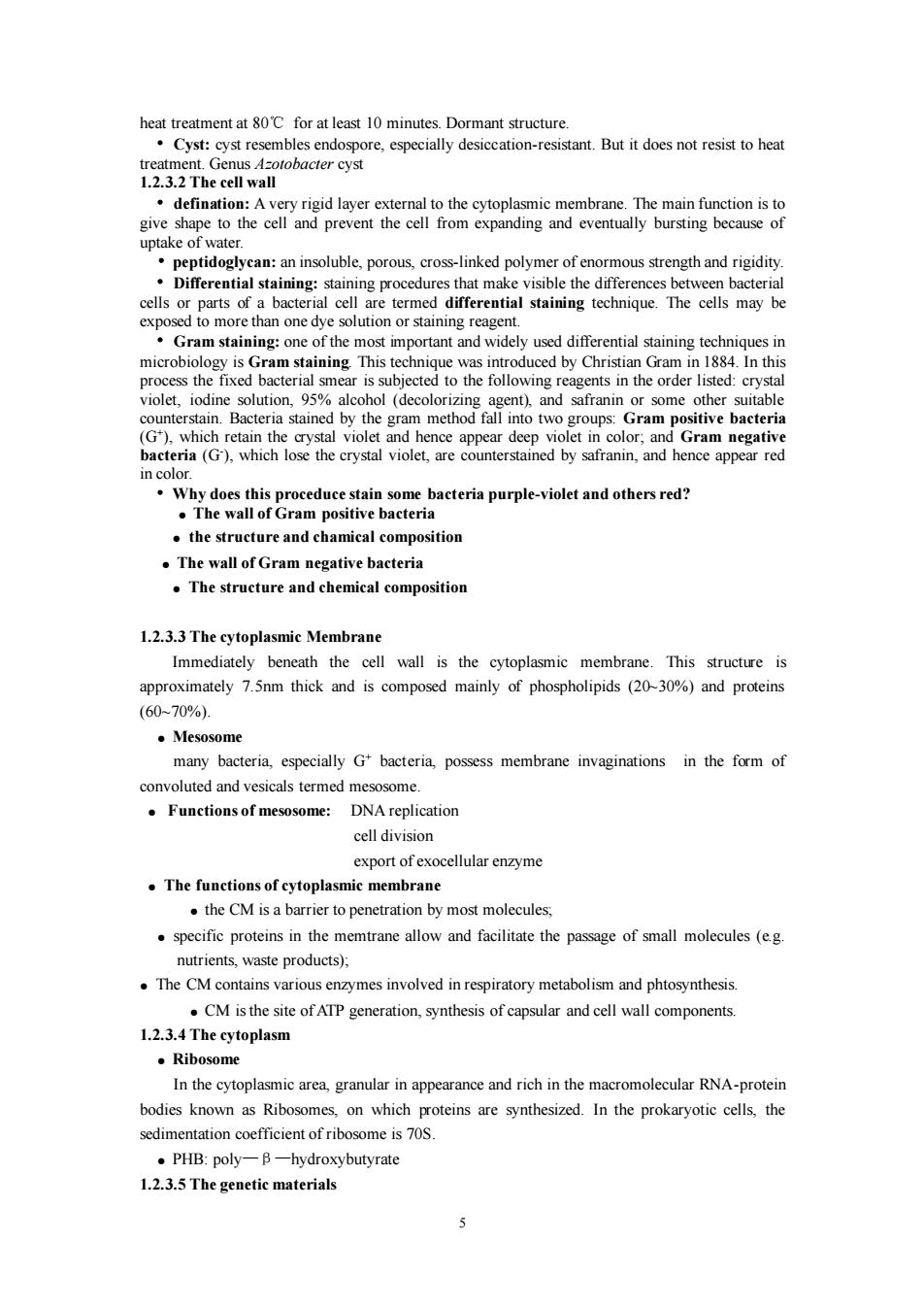正在加载图片...

5 heat treatment at 80℃ for at least 10 minutes. Dormant structure. • Cyst: cyst resembles endospore, especially desiccation-resistant. But it does not resist to heat treatment. Genus Azotobacter cyst 1.2.3.2 The cell wall • defination: A very rigid layer external to the cytoplasmic membrane. The main function is to give shape to the cell and prevent the cell from expanding and eventually bursting because of uptake of water. • peptidoglycan: an insoluble, porous, cross-linked polymer of enormous strength and rigidity. • Differential staining: staining procedures that make visible the differences between bacterial cells or parts of a bacterial cell are termed differential staining technique. The cells may be exposed to more than one dye solution or staining reagent. • Gram staining: one of the most important and widely used differential staining techniques in microbiology is Gram staining. This technique was introduced by Christian Gram in 1884. In this process the fixed bacterial smear is subjected to the following reagents in the order listed: crystal violet, iodine solution, 95% alcohol (decolorizing agent), and safranin or some other suitable counterstain. Bacteria stained by the gram method fall into two groups: Gram positive bacteria (G+ ), which retain the crystal violet and hence appear deep violet in color; and Gram negative bacteria (G- ), which lose the crystal violet, are counterstained by safranin, and hence appear red in color. • Why does this proceduce stain some bacteria purple-violet and others red? ● The wall of Gram positive bacteria ● the structure and chamical composition ● The wall of Gram negative bacteria ● The structure and chemical composition 1.2.3.3 The cytoplasmic Membrane Immediately beneath the cell wall is the cytoplasmic membrane. This structure is approximately 7.5nm thick and is composed mainly of phospholipids (20~30%) and proteins (60~70%). ● Mesosome many bacteria, especially G+ bacteria, possess membrane invaginations in the form of convoluted and vesicals termed mesosome. ● Functions of mesosome: DNA replication cell division export of exocellular enzyme ● The functions of cytoplasmic membrane ● the CM is a barrier to penetration by most molecules; ● specific proteins in the memtrane allow and facilitate the passage of small molecules (e.g. nutrients, waste products); ● The CM contains various enzymes involved in respiratory metabolism and phtosynthesis. ● CM is the site of ATP generation, synthesis of capsular and cell wall components. 1.2.3.4 The cytoplasm ● Ribosome In the cytoplasmic area, granular in appearance and rich in the macromolecular RNA-protein bodies known as Ribosomes, on which proteins are synthesized. In the prokaryotic cells, the sedimentation coefficient of ribosome is 70S. ● PHB: poly—β—hydroxybutyrate 1.2.3.5 The genetic materials5 heat treatment at 80℃ for at least 10 minutes. Dormant structure. • Cyst: cyst resembles endospore, especially desiccation-resistant. But it does not resist to heat treatment. Genus Azotobacter cyst 1.2.3.2 The cell wall • defination: A very rigid layer external to the cytoplasmic membrane. The main function is to give shape to the cell and prevent the cell from expanding and eventually bursting because of uptake of water. • peptidoglycan: an insoluble, porous, cross-linked polymer of enormous strength and rigidity. • Differential staining: staining procedures that make visible the differences between bacterial cells or parts of a bacterial cell are termed differential staining technique. The cells may be exposed to more than one dye solution or staining reagent. • Gram staining: one of the most important and widely used differential staining techniques in microbiology is Gram staining. This technique was introduced by Christian Gram in 1884. In this process the fixed bacterial smear is subjected to the following reagents in the order listed: crystal violet, iodine solution, 95% alcohol (decolorizing agent), and safranin or some other suitable counterstain. Bacteria stained by the gram method fall into two groups: Gram positive bacteria (G+ ), which retain the crystal violet and hence appear deep violet in color; and Gram negative bacteria (G- ), which lose the crystal violet, are counterstained by safranin, and hence appear red in color. • Why does this proceduce stain some bacteria purple-violet and others red? ● The wall of Gram positive bacteria ● the structure and chamical composition ● The wall of Gram negative bacteria ● The structure and chemical composition 1.2.3.3 The cytoplasmic Membrane Immediately beneath the cell wall is the cytoplasmic membrane. This structure is approximately 7.5nm thick and is composed mainly of phospholipids (20~30%) and proteins (60~70%). ● Mesosome many bacteria, especially G+ bacteria, possess membrane invaginations in the form of convoluted and vesicals termed mesosome. ● Functions of mesosome: DNA replication cell division export of exocellular enzyme ● The functions of cytoplasmic membrane ● the CM is a barrier to penetration by most molecules; ● specific proteins in the memtrane allow and facilitate the passage of small molecules (e.g. nutrients, waste products); ● The CM contains various enzymes involved in respiratory metabolism and phtosynthesis. ● CM is the site of ATP generation, synthesis of capsular and cell wall components. 1.2.3.4 The cytoplasm ● Ribosome In the cytoplasmic area, granular in appearance and rich in the macromolecular RNA-protein bodies known as Ribosomes, on which proteins are synthesized. In the prokaryotic cells, the sedimentation coefficient of ribosome is 70S. ● PHB: poly—β—hydroxybutyrate 1.2.3.5 The genetic materials